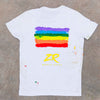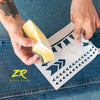

All you need to know about toddler sublimation shirts
Dec 28, 2022
What is sublimation? How can we sublimate our shirts? If you are finding these answers then in this blog, we are going to talk about toddler sublimation shirts. Despite the spectacular growth of digital textile printing, only sublimation printing is predicted to be the most lucrative printing technique. Printing on a wide range of things, including accessories, clothing, and home décor is done using sublimation technology. Due to its versatility, sublimation printing is highly popular. The clothing sublimation industry is expected to reach $10.67 billion by 2030. How does sublimation printing operate and what is it? Let's examine its benefits in more detail, as well as how Prints makes use of them.
To understand toddler sublimation shirts, one should know about the process first. So, let’s just understand the etymology. Instead of printing on top of your design, sublimation printing embeds it into the product's material. Numerous objects, including hard-surfaced mugs and various textile goods, may be printed with them. The best printing technique for light-colored textiles that are either 100% polyester, polymer-coated, or blends of polyester is sublimation. Shirts, sweaters, leggings, socks, laptop sleeves, backpacks, and even home décor may all be printed on with sublimation technology. The outcomes are outstanding!
I'm not lying when I claim it's easy to learn how to utilize sublimation. Yes, there are some components needed, but they are quite easy to use and easily accessible.
You have the option of using a sublimation printer or acclimatizing an inkjet printer to use sublimation ink. I've had no issues with this Epson printer. It is important to remember that sublimation ink is required to sublimate.
The ink that comes with the inkjet printer, for instance, cannot be utilized; in fact, no ink from the inkjet printer should be used in the printer that you want to use for sublimation. My preferred brand of ink, Wokok, is used by me. (Simplify it)
Heat pressing is yet another important. It’s really an important step, so don't skip it. The particular coating on this one-of-a-kind paper for the sublimation process. This will aid with the transfer by pressing and warming you choose a heat press with a sufficiently large heat plate to fit the desired patterns. I do not recommend attempting this since it cannot be done with an iron.
To generate graphics and designs for printing, you will require design software. I like using Silhouette Studio since it's free to use and download from their website. A fantastic alternative is Procreate, which I've been using on my iPad. Using the tool I stated above, you can create your text and images, but you can also buy designs that have already been created for you, which is amazing! My favorite locations to purchase designs are Etsy, Creative Fabrica, and design bundles.
Butcher paper protects the garment from the heat plate while preventing colors from being pressed onto the back of the item. I purchased mine on Amazon for a giant roll at a great price. Numerous types of dust and lint may be found on T-shirts and other garments. You may make sure your design is as clear and high-quality as possible with a quick, 3-second lint roll.
I think the most fascinating part of sublimation is finding a surface to sublimate on, so this is an excellent query. Inks and polymers in the transfer medium are joined by sublimation. Therefore, anything with a substantial amount of polyester should work. Look for fabrics that include at least 50% polyester, preferably 65%, as a general guideline. The higher the polyester content of the fabric, the better the inks will stick, creating a sharp and clear image. Simply typing "sublimation blank spaces" into Google will bring up several companies that sell pre-made items that are ready to be sublimated. There are blankets, coasters, mugs, water bottles, shirts, socks, and ties for sale. The options are essentially limitless.
No, they can be sublimated even if they are not entirely made of polyester. T-shirts made entirely of polyester are unpleasant to wear, therefore I don't suggest buying any to wear or sell. T-shirts that include 50% to 65% polyester are soft and comfortable while yet effectively absorbing ink. There is no denying, however, that 100% polyester produces the clearest and brightest transfers.
Since sublimation relies on polymers contained in shirts and other things to perform its task, it won't adhere to natural fibers like cotton or wool. But there is a practical choice. If you want to sublimate onto 100% cotton, you will need to use spray brilliant, which I have had success with. Use this spray to completely cover the area of the fabric you want to sublimate, then let it air dry. Once the material has dried, just sublimate as usual for stunning results! Cotton may be sublimated to produce stunning, vibrant effects!
The textile industry divides sublimation-printed products. Businesses exclusively sublimate laptop sleeves, towels, blankets, and socks that are already created. All other sublimation products are created using the cut-and-sew method. The majority of our clothing is cut and made by companies, but they also offer accessories and home decor. Let's examine some sublimation samples and compare ready-made shirts to hand-sewn all-over print shirts to better comprehend the distinctions between the two product categories. The design is imprinted directly on the clothes when you purchase pre-made sublimation shirts. The areas along the seams may be folded and not sublimated when the sublimation paper is parallel to the shirts, leaving white streaks on the garments. To prevent this, Companies cut and sew shirts with all-over prints from the ground up.
With the use of techniques like screen printing, transfer types of vinyl, and direct-to-garment printing, a design may be transferred to a variety of items. Most of these processes use different materials. Sublimation, however, is unique as it produces high-quality, brightly colored images that last and require little material. As an illustration, think about screen printing. Large open spaces for the gadget, sufficient airflow, pricey displays, and resources are required to get started. Why not simply print clothing? A big DTG printer, which costs at least thousands of dollars, is required for direct-to-garment printing. Additionally, upkeep and repairs could be unaffordable. In this situation, sublimation is used. For 100$ or less, Sublimation can help you. Only a printer, a heat press, sublimation paper, and drawings are required. If you own these instruments, you can use sublimation right away. I can personally attest that this process is quite user-friendly for beginners. My initial sublimation t-shirt came out fantastic. So you can say that Sublimation is fantastic.
Now that we have covered all the specifics of sublimation, let's move on to a more substantive lesson:
- You may make or download designs using software like Photoshop, Procreate, or Silhouette Studio.
- Print the design (be sure to mirror it!), using your sublimation printer and sublimation inks, onto sublimation paper.
- To pre-heat your heat-press, according to the directions on it.
- Mine sublimation is 365 F.
- Ready butcher paper. To prevent ink from transferring to the back of the shirt while sublimating a t-shirt, use a sheet of butcher paper between the garment and the heat plate. One must be on the press's base, one must be positioned between the object and the heat plate, and one must be positioned between the item and the heat plate.
- Use a heat press to transfer the design onto the shirt, pressing for 45-55 seconds with medium pressure. Place a sheet of butcher paper over the design before pressing
- Gently raise the pressing to discard the butcher paper and dying design.
- Take the garment out of the heat press once it has had a chance to cool significantly.
- That's all, anyone can do it easily
Sublimation paper is the special substance used to print the sublimation design. The following are some sublimation paper tips:
- Place the paper in the sublimation or conversion printer, right side up. Sublimation papers usually have a color or lettering to show which side is for printing.
- Be mindful of any letters or other features in your sublimation design that can seem reversed when printed.
- The design may be sublimated immediately without waiting for it to dry.
- Simply heat the pattern and put it onto your desired material.
Black shirts, however, do not respond well to sublimation. Because the sublimation ink on the clothing is darker, it will be harder to see. A blue pattern would be a very dark shade of blue on a black garment. However, there are several additional "sublimation on black shirt hacks" that may be found online. All of these employ a variety of substances. To give you the choice of using anything other than iron-on vinyl on dark apparel, I experimented with dark t-shirt transfer paper. Before I bought my Cutter equipment, I used to make all of our Easter shirts with my computer and transferring sheet. On any inkjet printer, print a design, then give it time to dry. Trim off any extra white paper if there is any.
Use Cold water by putting the item in a pail of ice water, sublimation ink can be erased from clothing. Because ink freezes more quickly in cold water, remove it as soon as you can. The ink is pressed down with a spatula once the cloth has fully absorbed it. Because of this, sublimation printer ink can only be partially removed. If you accidentally print something with your sublimation printer during sublimation printing, use this. Make use of this frequently! Use a bleaching chemical to remove the sublimation ink. After bleaching the clothing, let it an hour or so to rest. Before use, sublimation ink must be thoroughly dissolved. The object may then be washed and rinsed with ordinary soap and water.
Thanks for reading the article! I hope now you better know about toddler sublimation shirts. Leave comments, and ask questions for queries!





